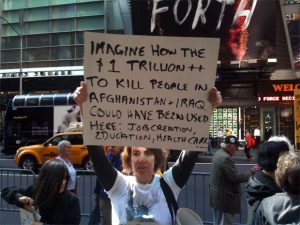
Protest in Times Square on the 10th anniversary of the war in Afghanistan – New York, NY – Oct 7, 2011 (credit: Monica Miller / WCBS 880)
On the 10th anniversary of America’s invasion of Afghanistan, an antiwar rally was held in Times Square. This photo shows a woman holding a sign that says, “Imagine how the $1 trillion to kill people in Afghanistan and Iraq could have been used here: job creation, education, health care”. In May of 2011, Osama Bin Laden was located in Pakistan and killed. Bin Laden was one of the driving factors of the invasion, so after his death, questions of the war’s purpose rose to prominence once again. As American society distanced itself from the Bush administration, many came to see that the War on Terror had been a costly sham plagued by xenophobia and fear[1]. Many felt that the Bush administration’s goals had not been realized, and the resources had been misplaced, especially after the financial meltdown of 2008[2]. This sign represents a common trend in antiwar dissent history: in times of war, Americans often ask, why is tax money being used to kill rather than improve the quality of life for Americans? The brunt of the cost of war often falls on those who had no say in its inception. In a country presently plagued with issues that impact a great deal of the populous, antiwar protest serves as an opportunity to confront the impact of war on the government’s attitude towards rectifying injustices at home.
[1] Howell, Jude, and Jeremy Lind. 2010. “Securing the World and Challenging Civil Society: Before and after the ‘War on Terror.’” Development and Change 41 (2): 279–91
[2] Howell, Jude, and Jeremy Lind. “Securing the World and Challenging Civil Society: Before and after the ‘War on Terror.’”, 279–91
